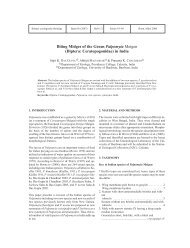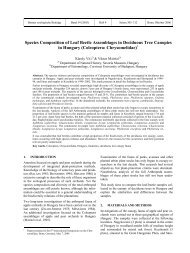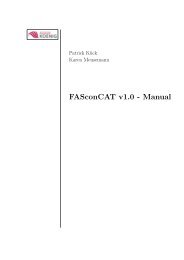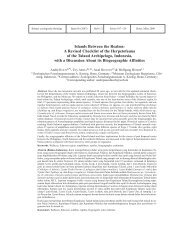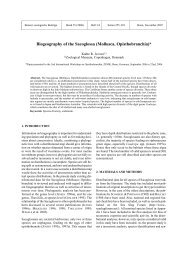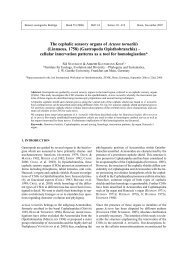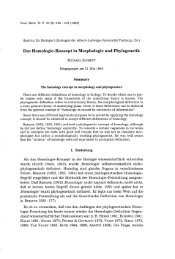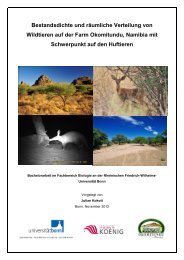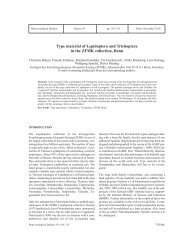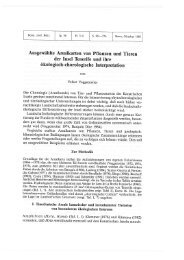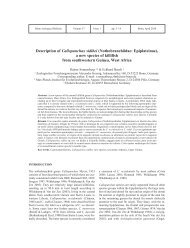Successful Husbandry and First Breeding of Varanus juxtindicus ...
Successful Husbandry and First Breeding of Varanus juxtindicus ...
Successful Husbandry and First Breeding of Varanus juxtindicus ...
You also want an ePaper? Increase the reach of your titles
YUMPU automatically turns print PDFs into web optimized ePapers that Google loves.
120<br />
WESIAK AND KOCH - HUSBANDRY AND BREEDING OF VARANUS JUXTINDICUS<br />
1999 but never reached publication (M. Bayless, pers.<br />
comm. to AK).<br />
These few examples demonstrate that the “rarelykept”<br />
V. <strong>juxtindicus</strong> seems to have been quite common<br />
in captivity during the 1990s, long before the taxonomic<br />
distinctness <strong>of</strong> this endemic Solomon monitor species<br />
was recognized (Böhme et al., 2002).<br />
Due to far-reaching changes in the personal<br />
circumstances <strong>of</strong> KW, the keeping <strong>and</strong> breeding <strong>of</strong> V.<br />
<strong>juxtindicus</strong> were ab<strong>and</strong>oned towards the end <strong>of</strong> 1996.<br />
His experiences with this species were very exciting<br />
<strong>and</strong> insightful. He believes that monitors can be kept<br />
<strong>and</strong> bred for a long time in captivity regardless <strong>of</strong> their<br />
size, providing the terrarium is <strong>of</strong> suitable size <strong>and</strong><br />
design, <strong>and</strong> that the keeper is competent <strong>and</strong> has a sense<br />
<strong>of</strong> responsibility. Personally, KW would not avoid the<br />
energy or expense <strong>of</strong> keeping these magnificent <strong>and</strong><br />
vivid monitors again.<br />
Finally, we would like to encourage keepers <strong>of</strong><br />
mangrove monitors <strong>and</strong> its allies, the so-called V. indicus<br />
species group (Ziegler et al., 2007), to publish their<br />
observations <strong>and</strong> experiences with these magnificent<br />
reptiles.<br />
Acknowledgements - We are grateful to Florian Wagner<br />
(Frankfurt) who was the first to draw our attention to the<br />
real identity <strong>of</strong> the monitor specimens under his care,<br />
which in the end turned out to be <strong>Varanus</strong> <strong>juxtindicus</strong>.<br />
Robert Mendyk (New York, USA) pointed our attention<br />
to further reports about reproduction <strong>of</strong> V. “indicus” in<br />
captivity. AK is thankful to the late Mark Bayless who<br />
sent him a draft about the successful breeding <strong>of</strong> what<br />
he thought was V. <strong>juxtindicus</strong>. KW would like to thank<br />
Pr<strong>of</strong>. Dr. Hans-Georg Horn (Sprockhövel) <strong>and</strong> Bernd<br />
Eidenmüller (Frankfurt) for helpful comments on the<br />
draft that was published in Elaphe. B. Eidenmüller<br />
(Frankfurt) also helped to digitally edit some older<br />
slides for the former Elaphe publication. Gunther Köhler<br />
(Senckenberg Museum, Frankfurt) <strong>and</strong> Felix Hulbert<br />
(Eltville) provided some slides <strong>of</strong> KW’s <strong>of</strong>fspring <strong>of</strong> V.<br />
<strong>juxtindicus</strong>. Ulla Bott (ZFMK, Bonn) kindly scanned<br />
them for publication. KW is also grateful to Pr<strong>of</strong>. Dr.<br />
Wolfgang Böhme (ZFMK, Bonn) who kindly helped<br />
to elucidate the identity <strong>of</strong> his monitors. We would like<br />
to stress that Pr<strong>of</strong>. Böhme never saw all pictures <strong>of</strong> the<br />
monitors, nor did he ever see KW’s specimens, until<br />
two adult V. <strong>juxtindicus</strong> were generously donated to the<br />
Museum Alex<strong>and</strong>er Koenig by Florian Wagner.<br />
We apologize for any confusion caused <strong>and</strong> hope<br />
that this translated <strong>and</strong> corrected version <strong>of</strong> the original<br />
article by Klaus Wesiak (2009) will help prevent future<br />
misidentification <strong>of</strong> V. <strong>juxtindicus</strong>. Mogens Andersen<br />
(Zoological Museum <strong>of</strong> the University <strong>of</strong> Copenhagen,<br />
Denmark) kindly provided photographs <strong>of</strong> the juvenile<br />
paratype <strong>of</strong> V. <strong>juxtindicus</strong> for comparisons with the<br />
monitor <strong>of</strong>fspring bred by Klaus Wesiak. Finally, we<br />
thank Wolfgang Böhme (ZFMK), Robert Neal (Brisbane,<br />
Australia), <strong>and</strong> three reviewers for improving the English<br />
language <strong>and</strong> for helpful comments on earlier drafts.<br />
References<br />
Auffenberg, W. 1981. The Behavioral Ecology <strong>of</strong><br />
the Komodo Monitor. University <strong>of</strong> Florida Press,<br />
Gainsville, 406 pp.<br />
Bennett, D. 1996. Warane der Welt, Welt der Warane.<br />
Edition Chimaira, Frankfurt/Main, 383 pp.<br />
Bennett, D. 1998. Monitor Lizards. Natural History,<br />
Biology <strong>and</strong> <strong>Husb<strong>and</strong>ry</strong>. Second edition, Edition<br />
Chimaira, Frankfurt/Main, 352 pp.<br />
Böhme, W., K. Philipp <strong>and</strong> T. Ziegler. 2002. Another<br />
new member <strong>of</strong> the <strong>Varanus</strong> (Euprepiosaurus)<br />
indicus group (Sauria, Varanidae): an undescribed<br />
species from Rennell Isl<strong>and</strong>, Solomon Isl<strong>and</strong>s.<br />
Salam<strong>and</strong>ra 38(1): 15–26.<br />
Böhme, W., K. Philipp <strong>and</strong> T. Ziegler 2004. V.<br />
<strong>juxtindicus</strong>. pp. 193–196 in Pianka, E. R. & D. R.<br />
King (Eds.): Varanoid lizards <strong>of</strong> the world. Indiana<br />
University Press, Bloomington & Indianapolis.<br />
Böttcher, M. 2007. Die Versorgung von Reptilien in<br />
der Terrarienhaltung mit ultraviolettem Licht.<br />
Elaphe 15(1): 32–37.<br />
Brockhaus 1982. Länder und Klima (Asien,<br />
Australien). Brockhaus, Wiesbaden, 240 pp.<br />
Eidenmüller, B. 1997. Warane - Lebensweise, Pflege,<br />
Zucht. Herpeton, Offenbach, 157 pp.<br />
Eidenmüller, B. 2003. Warane - Lebensweise, Pflege,<br />
Zucht. Herpeton, Offenbach, 2. Edition, 176 pp.<br />
Frank, W. 1985. Amphibien und Reptilien. pp.<br />
162–402, In: Isenbügel, E. & W. Frank (Eds.):<br />
Heimtierkrankheiten. Verlag Eugen Ulmer,<br />
Stuttgart, 402 pp.<br />
Horn, H.-G. 2004. Beleuchtung im Vivarium<br />
(Terrarium, Paludarium). pp. 168–253, in: Sauer,<br />
K., B. Steck, H. Schuchart & H.-G- Horn (Eds.):<br />
Praxis Ratgeber Vivarienbeleuchtung. Edition<br />
Chimaira, Frankfurt, 287 pp.<br />
Horn, H.-G. <strong>and</strong> G.-J. Visser. 1989. Review <strong>of</strong><br />
reproduction <strong>of</strong> monitor lizards <strong>Varanus</strong> ssp. in<br />
captivity. International Zoo Yearbook 28: 140–150.




